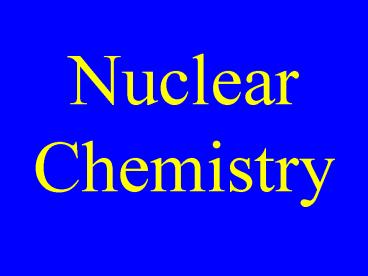Nuclear Chemistry
1 / 42
Title:
Nuclear Chemistry
Description:
Nuclear Chemistry Radioactive Nucleii A nucleus that spontaneously decomposes Isotopes Elements with the same atomic number, but different mass number Isotopes All ... –
Number of Views:36
Avg rating:3.0/5.0
Title: Nuclear Chemistry
1
Nuclear Chemistry
2
Nuclear Chemistry
- The study of reactions that take place in the
nucleii of atoms
3
Chemical Reactions
- In normal chemical reactions, only the electrons
are involved
4
Radioactive Nucleii
- A nucleus that spontaneously decomposes
5
Isotopes
- Elements with the same atomic number, but
different mass number
6
Isotopes
- Elements with numbers of protons, but ? numbers
of neutrons
7
Isotopes
- All elements have at least one radioactive isotope
8
Radiation
- The emission of particles rays from
spontaneously decomposing nucleii
9
Modes of Decay
- Alpha emission
- Beta emission
- Gamma emission
- Positron emission
- K-electron capture
10
Drill
- Name five types of radiation
11
Alpha Particle (a)
- Helium nucleus
- 2 protons 2 neutrons
- mass 4 amu
- charge 2
- Penetration power small
12
Beta Particle (b)
- High speed electron
- 1 electron
- mass 1/1836 amu
- charge -1
- Penetration power medium
13
Gamma Ray (g)
- High energy photon
- Electromagnetic wave
- mass 0
- charge 0
- Penetration power great
14
Positron (p)
- Positive electron
- 1 positive electron
- mass 1/1836 amu
- charge 1
- Penetration power medium
15
K-capture
- The capture of an inner level e- by the nucleus
- 1 electron
- mass 1/1836 amu
- charge -1
16
Nuclear Symbol
- Alpha 24He or 24a
- Beta -10e or 10b
- Gamma 0 0 ?
- Positron 10e
- K-electron -10e
17
Fission
- The splitting of a nucleus into smaller nucleii
involving the release of energy
18
Fusion
- The combining of smaller nuclei into a larger one
involving the release of energy
19
Transmutation Rxns
- Nuclear reactions in which one element is changed
into another
20
Transmutation Rxns
- Reactions in which the nucleus of an atom is
changed
21
Transmutation Rxns
- Both fission fusion are examples of
transmutation rxns
22
Transmutation Rxns
- Can occur through emission of or bombardment by
radioactive particles
23
Transmutation Rxns
- b emission of Pm-142
- a emission of U-238
- K-capture by O-15
- p addition of O-18
24
Transmutation Rxns
- a emission of U-238 followed by two separate b
emissions
25
Transmutation Rxns
- a bombardment of Th-234 followed by two separate
b emission
26
Predict Products
- a Neutron absorption by U-238 followed by two
separate b emission
27
Predict Products
- a emission of O-18 followed by a
- b emission
28
Predict Products
- K-capture by V-45 followed by neutron emission
then a emission
29
Decay Rate
- The rate at which a radioactive nucleus breaks
down
30
Half-Life
- The time it takes for 50 of the radioactive
nucleii to decompose
31
Decay Rate
- Rate kdX/dt
- ln(Xo/X) kt1/2
- k 0.693/t1/2
- t1/2 half-life
32
Drill
- Predict the products in each step when B-12 goes
through a bombardment followed by b emission.
33
1st Order Age Dating Formula
- t ln(Xi/Xf)t1/2
- 0.693
34
- Calculate the age of a skeleton found with 0.125
C-14 when atmospheric C-14 1.00 . t1/2 C-14
5720 yr
35
- Calculate the age of a tooth found with 0.00132
C-14 when atmospheric C-14 1.00 . t1/2 C-14
5720
36
- Calculate the age of a bone found with 0.000300
C-14 when atmospheric C-14 1.00 . t1/2 C-14
5720
37
Mass-Energy Relations
- DE Dmc2
38
Nuclear Fact
- The mass of any nuclei is different than the sum
of the masses of its protons neutrons
39
Nuclear Fact
- The energy corresponding to the mass difference
can be solved using - DE Dmc2
40
Binding Energy
- The energy that holds a nucleus together which
corresponds to Dm of nucleus
41
In an atomic bomb, 40.00 kg of U-235 (235.401) is
split into Ba-144 (143.223) Kr-89 (89.335) 2
neutrons (1.014). A) Calculate the energy
released. B) Calculate the wavelength of the g
ray
42
Show neutron bombardment of Ra-223 followed by 3
alpha emissions































